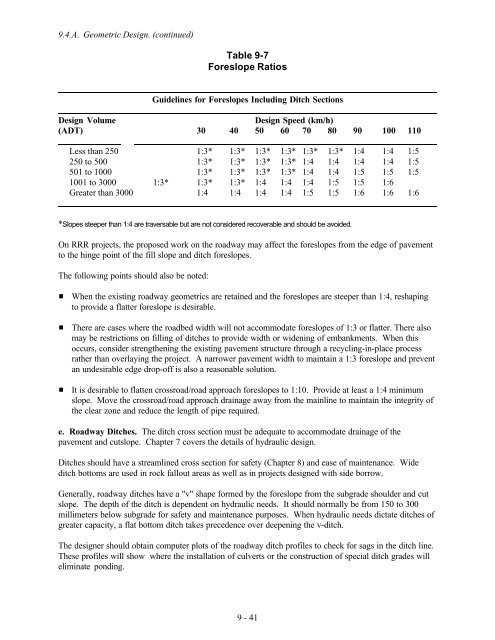FLH PDDM Chapter 9 - Eastern Federal Lands Highway Division
FLH PDDM Chapter 9 - Eastern Federal Lands Highway Division
FLH PDDM Chapter 9 - Eastern Federal Lands Highway Division
You also want an ePaper? Increase the reach of your titles
YUMPU automatically turns print PDFs into web optimized ePapers that Google loves.
9.4.A. Geometric Design. (continued)Table 9-7Foreslope RatiosGuidelines for Foreslopes Including Ditch SectionsDesign VolumeDesign Speed (km/h)(ADT) 30 40 50 60 70 80 90 100 110Less than 250 1:3* 1:3* 1:3* 1:3* 1:3* 1:3* 1:4 1:4 1:5250 to 500 1:3* 1:3* 1:3* 1:3* 1:4 1:4 1:4 1:4 1:5501 to 1000 1:3* 1:3* 1:3* 1:3* 1:4 1:4 1:5 1:5 1:51001 to 3000 1:3* 1:3* 1:3* 1:4 1:4 1:4 1:5 1:5 1:6Greater than 3000 1:4 1:4 1:4 1:4 1:5 1:5 1:6 1:6 1:6*Slopes steeper than 1:4 are traversable but are not considered recoverable and should be avoided.On RRR projects, the proposed work on the roadway may affect the foreslopes from the edge of pavementto the hinge point of the fill slope and ditch foreslopes.The following points should also be noted:When the existing roadway geometrics are retained and the foreslopes are steeper than 1:4, reshapingto provide a flatter foreslope is desirable.There are cases where the roadbed width will not accommodate foreslopes of 1:3 or flatter. There alsomay be restrictions on filling of ditches to provide width or widening of embankments. When thisoccurs, consider strengthening the existing pavement structure through a recycling-in-place processrather than overlaying the project. A narrower pavement width to maintain a 1:3 foreslope and preventan undesirable edge drop-off is also a reasonable solution.It is desirable to flatten crossroad/road approach foreslopes to 1:10. Provide at least a 1:4 minimumslope. Move the crossroad/road approach drainage away from the mainline to maintain the integrity ofthe clear zone and reduce the length of pipe required.e. Roadway Ditches. The ditch cross section must be adequate to accommodate drainage of thepavement and cutslope. <strong>Chapter</strong> 7 covers the details of hydraulic design.Ditches should have a streamlined cross section for safety (<strong>Chapter</strong> 8) and ease of maintenance. Wideditch bottoms are used in rock fallout areas as well as in projects designed with side borrow.Generally, roadway ditches have a "v" shape formed by the foreslope from the subgrade shoulder and cutslope. The depth of the ditch is dependent on hydraulic needs. It should normally be from 150 to 300millimeters below subgrade for safety and maintenance purposes. When hydraulic needs dictate ditches ofgreater capacity, a flat bottom ditch takes precedence over deepening the v-ditch.The designer should obtain computer plots of the roadway ditch profiles to check for sags in the ditch line.These profiles will show where the installation of culverts or the construction of special ditch grades willeliminate ponding.9 - 41
















